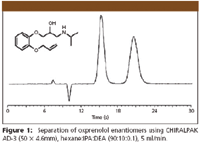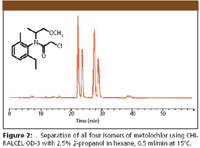Fast Enantioselective Chromatography with 3-µm Particles
The Application Notebook
The continuing and growing trend toward high-speed analysis in all fields of chromatography is also reflected in enantiomer separations. A variety of new 3-μm columns has been designed to meet this need. Applications of CHIRALCEL® OD-3 and CHIRALPAK® AD-3 in some enantiomer separations demonstrate the benefits of transitioning to such media.
The continuing and growing trend toward high-speed analysis in all fields of chromatography is also reflected in enantiomer separations. A variety of new 3-μm columns has been designed to meet this need. Applications of CHIRALCEL® OD-3 and CHIRALPAK® AD-3 in some enantiomer separations demonstrate the benefits of transitioning to such media.
There have been many publications in the scientific literature on the movement toward particles even smaller than 3-μm for HPLC analysis with the aim of achieving high resolution in the shortest possible time. Discussions on the merits and limitations on the use of a host of different particle diameters continue, but it is clear that there are benefits to the decrease in particle size for many HPLC separations.
Performance
One advantage of 3-μm particle diameters is that they may be used with conventional HPLC units, not requiring unit modifications. A comparison in column performance using an optimized, Agilent 1200 SL, and a standard, Agilent 1100, HPLC system for the enantiomeric separations showed that even for the smallest column (50 × 4.6 mm) there is an insignificant difference in column performance between the two systems.
Pressure Drop
By careful control of particle size distribution it is now possible to minimize the operating pressure while maintaining high efficiency. The average pressure drop increase, relative to a corresponding 5-μm particle, remains below two, a reduction of 38% over theory. This means that analyses are faster while still retaining reasonable operating pressures.
Fast Analysis
High-speed analyses require short, high performance columns. Columns, 50 mm long, with efficiencies of the order of 7000 plates are ideally suited to this need. Figure 1 shows the separation of oxprenolol enantiomers accomplished in 23 s. Such high performance can be achieved since 3-μm columns exhibit less change in efficiency with increasing flow rate than columns packed with larger particles.

Figure 1
High Efficiency
Another benefit to 3-μm particles is that difficult separations may be achieved. Figure 2 shows a separation of the four metolachlor diastereoisomers using two 150 × 4.6mm CHIRALCEL OD-3 columns coupled in series.

Figure 2

Chiral Technologies, Inc.
800 North Five Points Rd, West Chester, PA 19380
Tel 1-800-6-CHIRAL; www.chiraltech.com

Pick Your Poison. Isolation of Paclitaxel (Mar 2025)
March 7th 2025The diterpenoid, paclitaxel, which was identified as a potent chemotherapy agent for breast and ovarian cancer originates from the Pacific Yew tree. The isolation of paclitaxel from its major impurities is shown with the use of Hamilton’s PRP-1 (5 µm) HPLC column.














